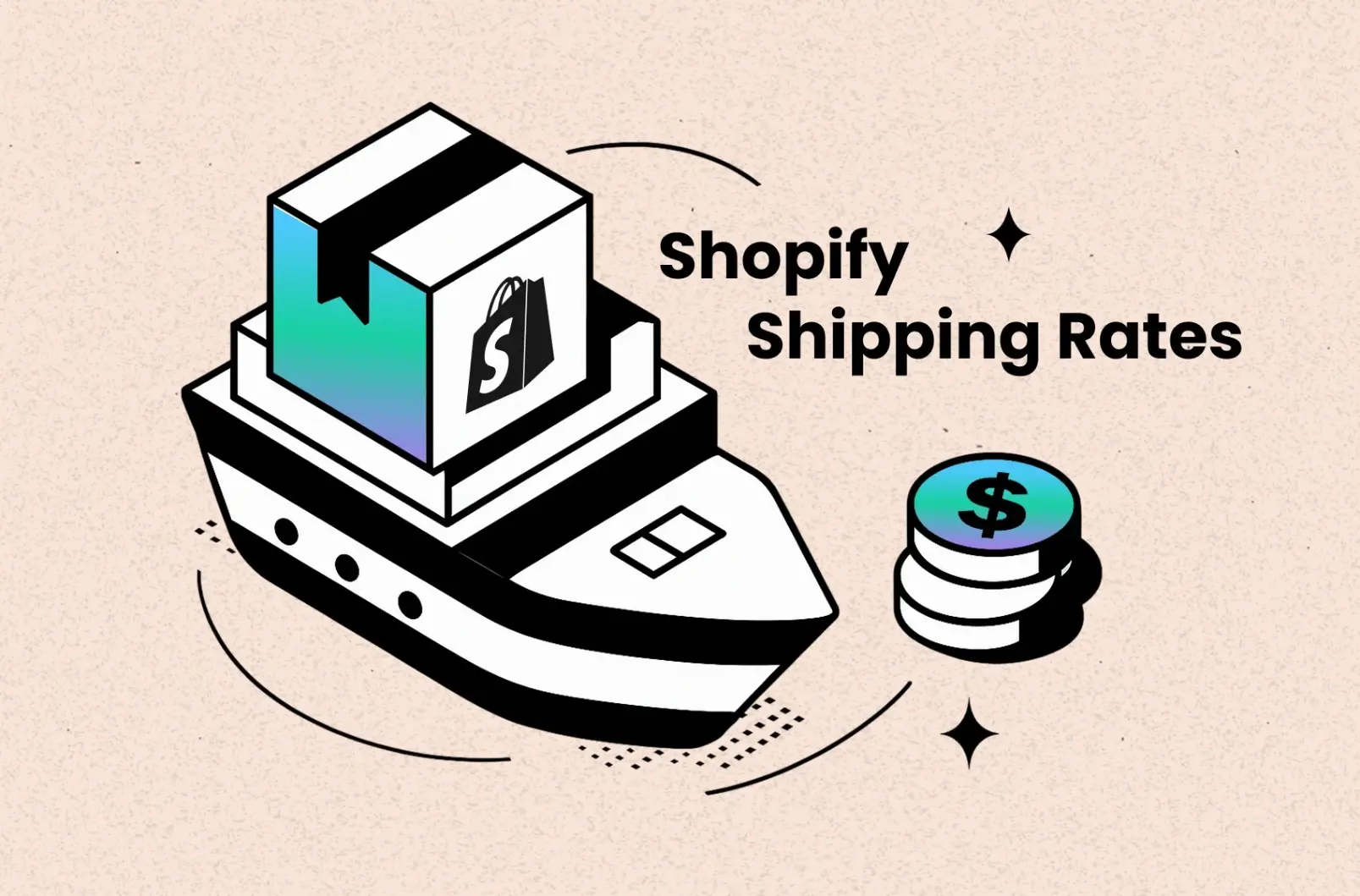Shopify Shipping Rates: The Basics Explained

Setting up Shopify shipping rates can feel overwhelming at first. But don’t worry — understanding the basics doesn’t have to be complicated.
Whether you’re trying to decide between flat-rate, weight-based, or price-based shipping, this guide will help you get a clear picture of your options.
We’ll walk you through the key types of Shopify shipping rates, when to use each one, and how to set them up so your checkout process runs smoothly without any guesswork.
Let’s get started!
What Are Shopify Shipping Rates?
Shopify shipping rates are the fees you charge customers for delivering their orders—and how they appear at checkout depends on how you set them up in your store.
Setting the right shipping rates is essential—it impacts your conversion rate, net profit margin, and your customers’ buying experience.
Shipping cost, conversion rate, and net profit margin are three key metrics out of many business performance metrics every store owner should track. Use a profit margin calculator to stay on top of your margins and spot any drops early.
Together, they help you understand if your shipping rates are helping or hurting your growth.
Main Types of Shopify Shipping Rates
Here’s a quick overview of the options available to you:
Shipping Rate Type | How It Works | Best For |
|---|---|---|
Flat Rates | Fixed cost per order or condition (e.g., $5 shipping fee) | Simplicity, predictability |
Price-Based Rates | Changes based on order value (e.g., Free shipping over $100) | Incentivizing larger orders |
Weight-Based Rates | Adjusted by total cart weight (e.g., 0–2kg = $4, 2–5kg = $7) | Stores with variable product sizes |
Free Shipping Rates | Set to $0 manually using flat rate | Boosting conversions |
Calculated Rates | Real-time fees pulled from carriers or apps | Accurate, dynamic pricing |
Flat Shipping Rates
A flat shipping rate in Shopify is a fixed shipping cost you set per order or per condition, regardless of the exact items in the cart.
Shopify allows you to create flat rates based on general conditions, item weight, or cart value:
Type | How It Works | Best For |
|---|---|---|
General Flat Rate | Same shipping fee applied to all orders in a shipping zone | Simple stores with low variation in orders |
Price-Based Rate | Shipping cost changes based on order value (e.g. $0–$50 = $5) | Stores with frequent upsells or large carts |
Weight-Based Rate | Shipping cost changes based on weight ranges (e.g. 0–2kg = $8) | Stores with varied product weights |
Free Shipping Rates
Free shipping rates are flat rates set to $0, meaning your customers won’t pay anything extra for delivery. You can apply them to all orders or only when certain conditions are met—like cart value or weight.
Example:
If you want to offer free shipping on orders above $75, set up a price-based flat rate of $0 for carts over that amount.
You can also:
- Set a general flat rate of $0 for all orders
- Combine with discount codes or promotional campaigns
Calculated Shipping Rates
Calculated shipping rates are real-time shipping costs pulled from carriers or apps. When a customer checks out, Shopify sends their order details to a connected carrier or shipping app, which returns live shipping prices.
Carrier-Calculated Rates
Carrier-calculated rates come directly from carriers like Canada Post, UPS, or FedEx, depending on your Shopify plan and location.
Example: A U.S. customer sees real-time Canada Post rates at checkout, based on your package size, weight, and delivery address. This helps automate pricing and keeps costs accurate.
App-Calculated Rates
Some advanced Shopify shipping rate calculators can calculate rates based on custom rules, multiple carriers, or even offer more flexible pricing structures than built-in carrier options.
Example: If you sell internationally or need specific shipping logic (e.g., same-day delivery), apps can help you build those rules into the checkout process.
How to Choose the Right Shopify Shipping Rates
There’s no one-size-fits-all—but most Shopify store owners start with simple flat or free shipping, then use Shopify fees calculator to test calculated rates as their business grows.
Below are four key factors to consider:
- Product Type: Are your products light, heavy, or bulky? Weight-based or calculated rates are better for heavier items, while flat or free rates work well for smaller or standard-sized products.
- Margins and Budget: Know how much shipping eats into your profit margin. If your margins are tight, consider passing some shipping costs to customers using flat or calculated rates.
- Fulfillment Method: In-house shipping gives you more control over rates. Meanwhile, Third-party logistics (3PL) may require calculated or app-based rates.
- Customer Expectations: Customers today often expect fast and affordable shipping—sometimes even free. Offering free shipping over a certain amount can boost average order value.
Track and Optimize Shipping Costs with TrueProfit
Setting your shipping rates is just one part of the puzzle—tracking them accurately is what protects your margins. That’s where profit tracker TrueProfit comes in.
TrueProfit lets you choose how to calculate shipping costs based on your business model:
- Quantity-based shipping: Calculates shipping based on the number of units in an order.
- Weight-based shipping: Calculates shipping using the total order weight.
Once set, TrueProfit automatically tracks these costs across every product and channel—alongside your ad spend, cost of goods sold (COGS), and other key metrics. That means you get a real-time view of your true profit per order, without the spreadsheets or guesswork.
If you want to set up smarter shipping rules and understand how those costs impact your bottom line, TrueProfit gives you the clarity to do both.
Understanding Shopify shipping rates is an important step in setting up your store for success. Whether you choose flat-rate, weight-based, or price-based shipping, the right option depends on your products and customers. Take your time to explore and test what works best for your business.
Lila Le is the Marketing Manager at TrueProfit, with a deep understanding of the Shopify ecosystem and a proven track record in dropshipping. She combines hands-on selling experience with marketing expertise to help Shopify merchants scale smarter—through clear positioning, profit-first strategies, and high-converting campaigns.




 Shopify profits
Shopify profits


